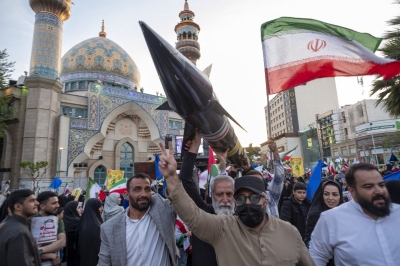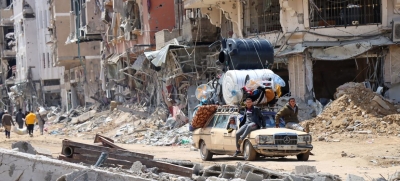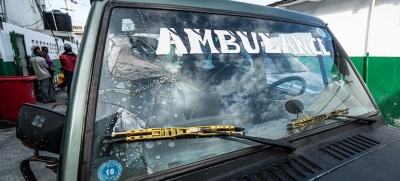UNITED NATIONS, Jan 19 (IPS) — Gaza’s healthcare system is “on its knees” as ongoing hostilities force hospitals to operate beyond their capacity and displace their healthcare workers, according to a WHO expert.
On Wednesday, WHO Health Emergency Officer Sean Casey spoke with reporters in New York on the healthcare crisis in Gaza. Following a five-week visit to the region, Casey elaborated on the WHO team’s work during his visit and their findings on the hospitals that were still running amidst the outbreak of violence since October 7. During his visit, he visited six out of the 16 hospitals still operating in the Gaza Strip. He described them as either “minimally or partially functioning” with the limited medical supplies and personnel available to them. But without unfettered access to medical supplies or fuel to run generators in the facilities, the hospitals will not be able to stay open.
“Every time I went to a hospital, I saw again and again the simultaneous humanitarian catastrophe that’s unfolding—we see it every day in Gaza getting worse—and the collapse of the healthcare system,” he said.
The growing number of trauma patients impacted by the ongoing attacks is currently overwhelming the healthcare system. There are up to 60,000 injured people in the region that require urgent care. Yet, there is a backlog of patients in hospitals, which only increases with each passing day. This is causing hospitals in the field and in towns to essentially play catch-up with the previous days’ cases. Patients with specialized needs, such as mothers requiring maternal or natal care or patients undergoing dialysis treatments, have also been struggling to get the care they need.

There are not enough doctors or nurses in the hospitals to accommodate the ever-increasing number of patients. Nasser Medical Complex in Khan Younis is currently operating with only 30 percent of its staff, according to Casey. There are reportedly over 25,000 doctors and nurses in Gaza. However, a large number of them are no longer in their homes and are unable to travel to work. This includes specialists in other fields of treatment. Areas around hospitals have been evacuated, as it’s been observed that hospitals have been hit by gunfire and bombings, rendering them rubble.
Al-Shifa Hospital, one of the largest still open, has been operating beyond its 700-bed capacity. It now serves as a “trauma stabilization point," according to Casey. Thousands of people, displaced by the loss of their homes, have taken refuge in the hospital, where there is nowhere else to go, filling up the operating rooms, corridors, and floors. For the patients, only five or six doctors and nurses are present.
“I saw patients in hospitals every day with severe burns, open fractures, waiting hours or days for care, and they would often ask me for food or water,” he said. “In addition to their injuries and illnesses, they’re crying out for the basic necessities of life.”
Constraints on security and access, as well as limitations on movement, have at times even prevented the safe passage of medical supplies and fuel. “The last week that I was in Gaza, we tried every single day for seven days to deliver fuel and supplies to the north, to Gaza City. And every day, those requests for coordinated movement were denied,” Casey said. Without a guarantee, fewer supply trucks are crossing the Rafah border. Meanwhile, needs are not being met adequately.
Rafah is currently hosting a million people, yet it does not have the health infrastructure to host so many internally displaced people. In order to address some of the care demands resulting from the hostilities, WHO is working to mobilize medical personnel and set up field hospitals.
The “rapid deterioration” of the healthcare system in Gaza is happening concurrently with the “dramatic humanitarian catastrophe” affecting the communities, Casey said. Due to the attacks, over 1 million civilians are now homeless and struggle with widespread food insecurity and a lack of access to potable water. For children, this will be particularly dangerous. UNICEF has warned that 10,000 children are at risk of dealing with child wasting, the most life-threatening form of malnutrition.
Casey remarked that a ceasefire would “provide immediate relief to the people of Gaza" and would allow for the UN and its partners to mobilize medicines, medical supplies, and other emergency resources.
More than a hundred days have passed since the beginning of the current humanitarian crisis in Gaza. The death toll has exceeded 24,000, and more than 60,000 have been injured.
Major leaders in the UN and its agencies, including Secretary-General António Guterres, have called for a humanitarian ceasefire to come into effect immediately to allow unimpeded aid to go through and to “tamp down the flames of wider war” that is threatening the region. “I am deeply troubled by the clear violation of international humanitarian law that we are witnessing,” he said to reporters on Monday.
The heads of WHO, UNICEF, and the World Food Programme (WFP) released a joint statement urging for the delivery of emergency humanitarian aid to mitigate the risk of famine and deadly disease outbreaks. UNRWA Commissioner-General Philip Lazzarini, in his statement to mark the 100 days, remarked that the current conflict in Gaza was a “man-made disaster compounded by dehumanizing language and the use of food, water, and fuel as instruments of war.”
IPS UN Bureau Report






